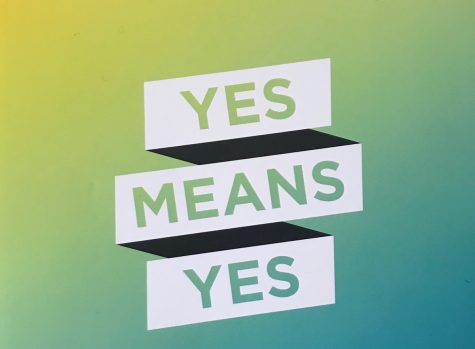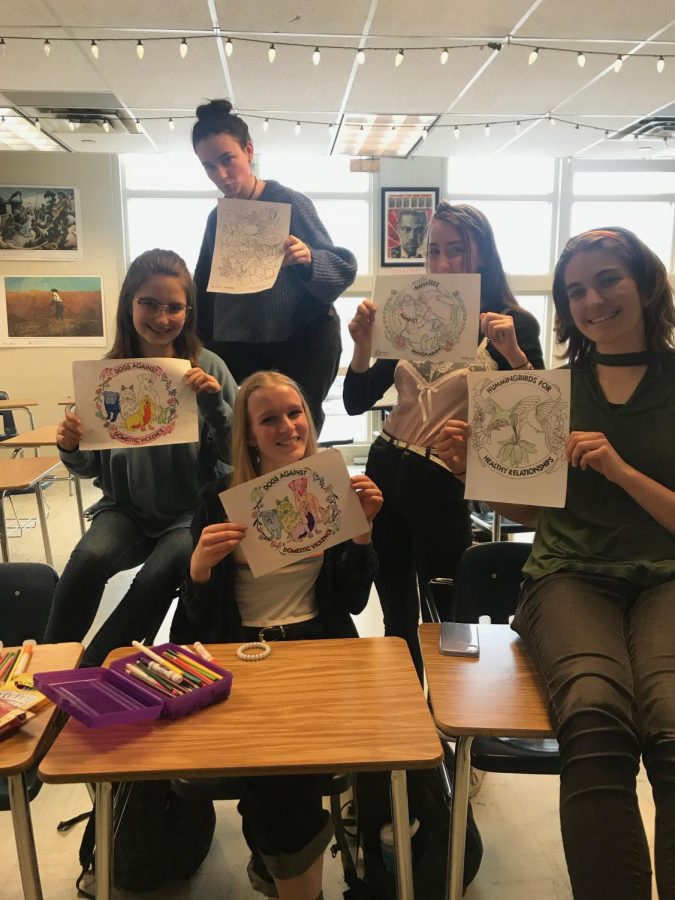The Student Alliance For Consent and Sexual Safety
Amaya Brooks, junior, Lili Stevens, Rory Mendelow Sara Proctor and Ellory Boyd, seniors, posed with pictures they colored during the first Student Alliance for Consent and Sexual Safety meeting.
The Student Alliance For Consent and Sexual Safety is a new program at Boulder High School started by seniors Sara Proctor, Ellory Boyd and Izzy Perez. It was an hour of discussion on Wednesday that concerned both the specific recent sexual assault cases in the BVSD community and the general issue of sexual assault. Dr. Hill came to discuss and answer questions the students had. The students who attended this meeting were able to get insight into what the administration and Boulder High as a whole will be doing to teach more about consent at school.
Dr. Hill said that the administration had “waited until January to create concrete plans.” Peers Building Justice, a youth group that explores how dating and sexual violence are sustained by power and control in our communities, has been helping with creating these plans. He says that Boulder High “already has a good relationship with Peers Building Justice,” and they will be a useful resource for students. Another question is who can make this healthy and positive change at Boulder High? He believes that “parents, teachers, faculty, and students” are the people who are going to be needed to make the change. He also said that the most recent cases that have come up are “not the first ones because many, unfortunately, go unnoticed. We’re not naive to the fact that this is happening.” If lessons taught during school hours is one way to create a healthy environment at Boulder High, how is every student going to get these lessons? He wonders, “how many students take a health class?” When polled, only one student out of the group of [however many] said they’d taken a health class.” Dr. Hill noted expanding the outreach of preexisting health education programs is one of the primary issues BHS’s administration has to consider. Mrs. Clark, who teaches LOYO (Living on Your Own), is working with representatives from MESA (Moving to End Sexual Assult) and SPAN (Safehouse Progressive Alliance for Nonviolence) to have presentations on sexual harassment and consent. Mrs. Rodrigez, who teaches AP Psychology, is also going help by integrating what consent means into the AP Psychology curriculum. “What’s not going to work,” Dr. Hill said, “is an assembly.”
Starting with juniors and seniors, the administration will call students down to these presentations. He doesn’t “want to mix freshmen and

Photo of the pamphlet given to the students by Dr. Hill.
seniors,” but still feels that it is important to teach younger students entering high school about consent and a way to “capture” every freshman at BHS is through Freshman Seminar. Dr. Hill had just come from a quick meeting with Mr. Hobbs and Mrs.Vuylsteke to add a lesson about consent and have a healthy conversation. Mr. Bishop is additionally going to be doing a character class with the football team, and Mr. Hartnett will bring in athletes on a Saturday to give a presentation. However, this isn’t a “one and done” situation. It’s great, sure, that teachers and administration are working to educate students about sexual assault and consent. Large gymnasiums filled with athletes who were forced to come in during the weekend will only work if the students want to be there and realize that what they are learning about is something serious that many women and men have to deal with on a day to day basis. Student’s most prominent teachers in life, however, are their parents and guardians. Teaching consent and having conversations in the home play a significant factor in the student’s mindset. Working with parents is as important as working with the kids.
“Dr. Hill has been beneficial,” Ellory Boyd said. He attended this meeting and distributed a small pamphlet to the students attending this discussion. This pamphlet was titled “Your Consent Guide” and had multiple different discussion topics such as asking and responding to consent. It might seem cheesy, but those who do not understand the underlying theme of consent are people who would benefit from reading it.


